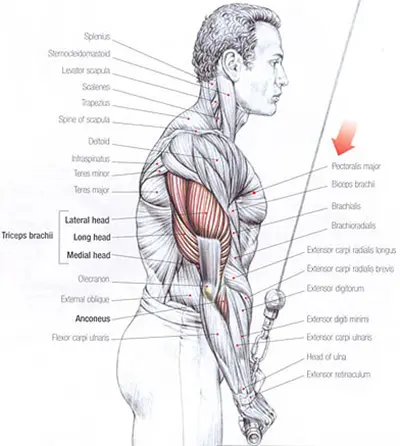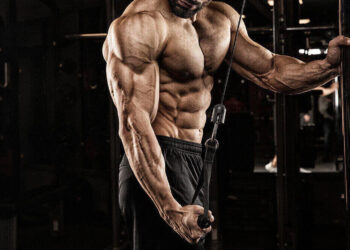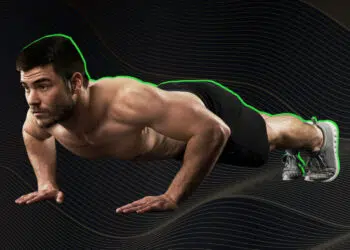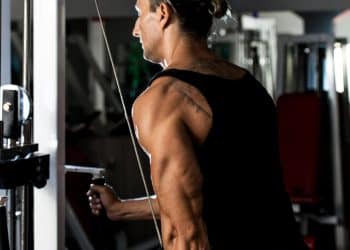Ask any bodybuilder to flex their arms, and invariably they’ll throw up a biceps pose. However, the biceps is usually the smallest upper arm muscle, and the triceps is considerably bigger and stronger.
Because of this biceps bias, many exercisers spend an inordinate amount of time trying to beef up their bis and not enough time training their tris. This can leave a lot of upper arm muscle mass left untapped.
If you want to build the biggest possible arms, you need to work your biceps AND your triceps, emphasizing the triceps slightly.
There are lot of triceps exercises to choose from, but let’s be honest, there are only so many pushdowns and dips you can do before you get bored.
So, liven up your triceps workouts with something new – TRX triceps extensions. In this guide, why reveal why and how to do this excellent exercise and the best variations and alternatives.
TRX Triceps Extensions – Muscles Worked
You probably won’t be all that surprised to learn that TRX triceps extensions work your triceps. It’s hardly a secret, right?
Level Up Your Fitness: Join our 💪 strong community in Fitness Volt Newsletter. Get daily inspiration, expert-backed workouts, nutrition tips, the latest in strength sports, and the support you need to reach your goals. Subscribe for free!
But the triceps are quite a complex muscle, so they’re worthy of a more in-depth description…
The triceps (full name triceps brachii) have two main functions: elbow extension and shoulder extension. They’re so called because they have three distinct heads, which gives them the horseshoe shape the triceps are famous for.

The three heads are:
- The long head
- The lateral head
- The medial head
While all three triceps heads share the same insertion point, the olecranon, which is a bony prominence at the top of the ulna near your elbow, they have three different origins.
The long head crosses the shoulder and the elbow and affects both these joints. In contrast, the lateral and medial heads only cross the elbow.
TRX triceps extensions work all three triceps heads but slightly emphasize the long head. That’s because the long head has to work hard to stabilize your shoulder joint and prevent it from moving.
While TRX triceps extensions are technically a single joint or isolation exercise, this exercise also involves your latissimus dorsi and rectus abdominus muscles. Both of these muscles act as stabilizers to keep your shoulders and torso steady while your elbows extend and flex.
How to Do TRX Triceps Extensions
Get more from TRX triceps extensions while keeping your risk of injury to a minimum by following these guidelines:
- Attach your TRX to a strong overhead anchor. Test the anchor to ensure it will support your weight.
- Shorten your suspension straps to about waist height.
- Standing with your back to the anchor point, hold a handle in each hand with an overhand grip. Extend your arms out in front of you and lean into the handles. Your upper arms should be parallel with each other and the floor.
- Bend your elbows and lower your head between your hands. Get a good stretch in your triceps.
- Extend your arms and repeat.
- Your shoulders should remain relatively stationary throughout this exercise, and most of the movement should come from your elbows.
Tips:
- Shorten the straps to make this exercise easier. This will put your body in a more upright position, so there is less weight on your arms.
- Alternatively, adopt a staggered stance and use your front foot to take some of the weight off your arms.
- Do TRX triceps extensions on your knees for an even easier option.
- Lengthen the straps and put your body in a more horizontal position to make this exercise harder.
- No TRX? No Problem! You can do a similar exercise using gymnastic rings, like this:
TRX Triceps Extensions Benefits and Drawbacks
Not sure if TRX triceps extensions deserve a place in your workouts? Think about these benefits and then decide!
Train your triceps anywhere and anytime
Armed with your TRX, gymnastic rings, or TRX alternative, you can train your triceps anywhere and anytime. Work out at home, in a hotel room, or at a park. All you need is a suitable anchor point.
A full-body exercise
Although technically an isolation exercise, TRX triceps extensions work several important muscles, including your shoulders, back, core, and legs. More muscles mean more calories burned, which makes this a useful weight loss exercise, which is something that can’t usually be said about triceps exercises.
Adjust the resistance instantly
You can adjust the resistance of this exercise simply by moving your feet. Walk backward to put more weight on your arms or forward to take some weight off. This means TRX triceps extensions suitable for all levels of exerciser and ideal for muscle-building mechanical drop sets.
Read more about drop sets here.
A full range of motion
TRX triceps extensions take your arms from full extension to full flexion, i.e., through the entire available range of motion. Not only that, there is tension on your triceps the entire time. This makes TRX triceps extension challenging and very effective for building muscle mass and strength.
While TRX triceps extensions are a mostly beneficial exercise, there are also a few drawbacks to consider:
Elbow pain
Some exercisers find that TRX triceps extensions cause or exacerbate existing elbow pain. This is probably because of the large range of motion and, in particular, the extreme joint flexion at the mid-point of each rep. You can reduce this problem by not bending your elbows as far.
Hard to quantify the resistance
While making TRX triceps extensions easier or harder is a simple matter of moving your feet, it’s impossible to say how much weight you are lifting. Because of this, it’s hard to quantify your workouts or measure how much stronger you are getting. However, you should see a noticeable increase in performance, i.e., more reps performed or a lower position of your body.
7 TRX Triceps Extensions Variations and Alternatives
TRX triceps extensions are a highly effective arm exercise, but that doesn’t mean you need to do them all the time. There are several variations and alternatives you can use to keep your workouts productive and interesting:
Level Up Your Fitness: Join our 💪 strong community in Fitness Volt Newsletter. Get daily inspiration, expert-backed workouts, nutrition tips, the latest in strength sports, and the support you need to reach your goals. Subscribe for free!
1. Bodyweight triceps extensions/skull crushers
No TRX? No problem! You can train your triceps using your body weight and a sturdy platform for your hands, such as an exercise bench, table, countertop, or a barbell in a squat rack. However, this exercise tends to be harder on the elbows than the TRX variation.
Steps:
- Place your hands on the platform about shoulder-width apart.
- Walk your feet back and into the push-up position with your knees, hips, and body straight. Move your feet a little further back, so your shoulders are now behind your hands rather than directly above them.
- Brace your core and pull your shoulders down and back for stability. Rotate your arms so your elbows are pointing down toward the floor. Do not let them flare out to the side, as this reduces the effectiveness of the exercise.
- Keeping your body straight and rigid, bend your arms while keeping your arms tucked into the side of your body.
- Lower your head down to your hands. Your upper arms should remain mostly stationary, and your elbows should be the only joints moving. Remember, this is NOT a push-up!
- Extend your arms and push yourself back up to the starting position without dropping your hips or losing core tension.
Muscles targeted:
- Primary: Triceps.
- Secondary: N/A.
Benefits:
- A more stable platform than TRX triceps extensions so potentially better for strength and hypertrophy as there is less chance of losing your balance.
- A more straightforward exercise to learn than the TRX version.
- No TRX or overhead anchor point is required.
Tips:
- Move your feet further back to make this exercise harder.
- Wear a weighted vest for a more intense workout.
- Experiment with a narrow, medium, and wide grip to see which you find more effective.
2. Cable overhead triceps extensions
This exercise uses much the same movement and range of motion as TRX triceps extensions. However, instead of adjusting the angle of your body to make the exercise harder or easier, you can just move the weight selector pin.
Steps:
- Attach a rope handle to a low pulley machine. Grab the end and then stand with your back to the pulley and your arms bent, hands on either side of your head.
- Step forward and into a staggered stance for stability. Brace your abs, and pull your shoulders down and back. Lean forward slightly from your hips.
- Keeping your upper arms close to your ears, extend your arms and squeeze your triceps hard.
- Bend your elbows as far as your flexibility allows, and then repeat.
Muscles targeted:
- Primary: Triceps.
- Secondary: N/A.
Benefits:
- This exercise takes your triceps through a large range of motion, from fully stretched to completely contracted.
- Easier to quantify the load and intensity of your workouts than with TRX triceps extensions.
- Use as little or as much weight as you want.
Tips:
- Keep your upper arms close to your ears to avoid turning this triceps exercise into a shoulder press.
- Experiment with different angles of your torso to see which position works best and feels most comfortable.
- This exercise can also be done seated instead of standing and using one arm at a time.
3. Dumbbell French press
There is nothing especially French about the French press. It neither comes from France nor has anything to do with its namesake coffee. However, despite the seemingly random name, this is a very effective exercise that’s an excellent alternative to TRX triceps extensions.
Steps:
- Seated or standing, hold a dumbbell above your head, so it’s vertical.
- Pull your upper arms in close to your ears, your shoulders down and back, and brace your abs.
- Without moving your upper arms, bend your elbows and lower the weight down behind your head. Get a good stretch in your triceps.
- Extend your arms and then repeat.
Muscles targeted:
- Primary: Triceps.
- Secondary: N/A.
Benefits:
- A low-tech exercise – all you need is a single dumbbell.
- It can be performed seated or standing as preferred.
- Takes the triceps through an extensive range of motion, from fully stretched to complete contraction.
Tips:
- You can also do French presses with a barbell or EZ bar.
- Do this exercise one arm at a time to identify and fix left-to-right strength imbalances.
- Keep your elbows pointing forward to maximize triceps engagement and avoid turning this exercise into an overhead press.
4. Skull crusher
Skull crushers are so-called because if you lower the bar too fast or fail mid-rep, you could find yourself with a barbell hitting your head. Needless to say, we’d prefer it if you avoid hurting yourself during your workouts! Anyway, regardless of its name, this is an excellent exercise for building bigger, stronger triceps.
Steps:
- Lie on your back on an exercise bench. Hold a barbell with an overhand, slightly narrower than shoulder-width grip. Press the bar up and hold it over your chest so your arms are straight.
- Keeping your upper arms vertical, bend your elbows and lower the bar down to your forehead.
- Extend your arms and repeat.
Muscles targeted:
- Primary: Triceps.
- Secondary: N/A.
Benefits:
- A challenging triceps exercise that you can do in any gym.
- It takes your triceps through a large range of motion.
- An effective triceps builder – a great hypertrophy exercise.
Tips:
- You can perform skull crushers with a straight barbell, EZ bar, or dumbbells as preferred.
- Use a slightly declined bench to increase long head triceps engagement.
- Lower the bar to the top of your head instead of your forehead to get a deeper stretch in your triceps.
5. Cable pushdown
Cable pushdowns are probably one of the most widely performed triceps exercises. This makes sense as they’re easy to learn and effective. Get the most from cable pushdowns by doing them correctly!
Steps:
- Attach a straight bar to a high pulley machine. Hold it with an overhand, shoulder-width grip.
- Pull your upper arms down and into your sides, and brace your abs. Stand with your feet about shoulder-width apart for balance.
- Keeping your torso stationary, extend your arms and push the bar down until your elbows are straight. Contract your triceps as hard as possible.
- Bend your elbows, raising the bar as high as you can without letting your arms move away from your sides.
Muscles targeted:
- Primary: Triceps.
- Secondary: N/A.
Benefits:
- An easy exercise to learn and master.
- Perfect for muscle-building drop-sets.
- Suitable for beginner, intermediate, and advanced exercisers.
Tips:
- Use an EZ bar or rope handle for variety.
- You can also do this exercise using one arm at a time.
- Try doing triceps cable pushdowns with a reverse or palms-up grip to hit your muscles from a different angle.
6. Diamond push-up
No TRX? No problem! You can still train your triceps using nothing but your body weight. The humble push-up is already an effective triceps exercise, but the diamond variation works even better.

Steps:
- Squat down and place your hands flat on the floor. Your thumbs and first fingers should touch and form a diamond or triangle shape.
- With straight arms, walk your feet out and back into the classic push-up position. Brace your abs.
- Next, bend your arms and lower your chest down to the backs of your hands. Keep your upper arms tucked in close to your sides.
- Push yourself back up and repeat.
Muscles targeted:
- Primary: Triceps.
- Secondary: N/A.
Benefits:
- You can do diamond push-ups anywhere and anytime.
- No equipment required.
- An excellent progression from regular push-ups.
Tips:
- Raise your feet on a bench to make this exercise more challenging.
- Bend your legs and rest on your knees to make it easier.
- Use push-up handles if the diamond hand position bothers your wrists.
7. Triceps dip
All types of dips work your triceps, but by adjusting the angle of your body, you can emphasize your chest or arms more. This version is much more triceps-dominant, which is why it made it onto our list of TRX triceps extension alternatives!
Steps:
- Use dipping bars that are no wider than shoulder-width apart. A wider grip will increase chest activation.
- Place your hands on the bars with your palms turned inward. Support your weight on straight arms.
- Let your legs hang down below you, and keep your torso as upright as possible. Some forward lean is unavoidable and expected, but try to keep it to a minimum.
- Bend your arms and descend until your elbows are bent to around 90 degrees or more. Tuck your arms in and imagine you are pointing your elbows behind you.
- Push yourself upward, extending your arms fully but not quite locking your elbows. Pause here for 1-2 seconds to really challenge your triceps.
- Descend and repeat.
Muscles targeted:
- Primary: Triceps.
- Secondary: Pectoralis major, deltoids.
Benefits:
- An effective way to overload your triceps with just your body weight.
- A compound exercise that trains all your major upper body pressing muscles.
- A superior triceps-building exercise.
Tips:
- Do weighted dips for a more intense workout.
- Superset with diamond push-ups for a no-frills but effective bodyweight triceps workout.
- Stretch a resistance band between the dip handles and stand or kneel on it to make this exercise easier.
Frequently Asked Question
Do you have a question about TRX triceps extensions or triceps training in general? No worries – we’ve got the answers!
1. How many reps and sets should I do to build bigger triceps?
Not so long ago, it was generally accepted that, to build muscle, you should do between 6-12 reps per set. This was often referred to as the hypertrophy rep range. More recent training information suggests you can build muscle by doing as many as 35 or more reps, provided you take your sets to within a couple of reps of failure.
Regarding sets, you should clock up between 10 and 20 per muscle group per week. This can be done in one workout but is better spread across several training sessions.
Read more about these topics here.
2. What is the best rep range to build triceps strength?
Unlike hypertrophy, where anywhere from 6-35 or more reps will produce results, building strength requires heavy weights and low reps. So, if you want to get stronger, you should do most of your training in the 1-5 rep range, using 85% or more of your one repetition maximum or 1RM for short.
3. How many times a week should I train my triceps?
It’s generally best to train most muscle groups twice per week. Muscles take between 48 to 72 hours to recover, so training them once a week is probably insufficient. Remember, though, that your triceps work hard during all the pushing exercises in your workouts, so you need to consider that volume when deciding how often to train your triceps.
4. Aren’t bench presses and shoulder presses enough for triceps?
While it’s true that bench presses and shoulder presses involve your triceps, they work as synergists or helper muscles. Your chest and shoulders are the stars of those exercises. So, if you want to maximize triceps strength or growth, they deserve some targeted exercises, too.
General pressing exercises WILL build and strengthen your triceps, but if you want to take them to the next level, you should also train them separately.
5. Are bodyweight exercises like dips and diamond push-ups good triceps builders?
Your muscles cannot differentiate between doing pushdowns on a state-of-the-art cable machine or doing diamond push-ups on a dirty concrete floor. So long as you train hard enough and work out consistently, your muscles will respond by getting bigger and stronger.
So, don’t worry if you can only do bodyweight exercises for your triceps – your workouts will still produce good results.
6. Some triceps exercises hurt my elbows. What should I do?
Some triceps exercises, including skull crushers and French presses, can be quite hard on the joints. If any of the exercises in this article bother your joints, you should do something else instead.
Also, double-check you are doing the bothersome exercise correctly and not using too much weight. Finally, consider wearing supportive elbow sleeves, which may help alleviate any joint aches and pains.
7. How do I work the different triceps heads?
All three triceps heads are involved in every triceps exercise you perform. That said, it IS possible to emphasize each head by changing the position of your upper arm. Check out these guides for more details:
- Best Lateral Head Triceps Exercises
- Best Long Head Triceps Exercises
- Best Medial Head Triceps Exercises
Wrapping Up
A lot of lifters wrongly assume that the only way to build big arms is with weights and machines. This is not true! You can beef up your biceps and triceps with bodyweight exercises like close-grip chin-ups, dips, and diamond push-ups.
But, as good as those moves are, TRX triceps extensions are potentially even better because they take your muscles through such an extensive range of motion and let you adjust the resistance just by moving your feet.
So, the next time the pushdown machine is busy, or you can’t find an EZ bar for skull crushers, break out your suspension trainer and give TRX triceps extensions a try; you’re gonna love them!
Interested in measuring your progress? Check out our strength standards for Bench Press, Push Ups, Shoulder Press, and more.








